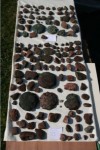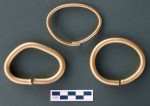 The ship itself seems to have disintegrated over the past 3000 years, but its cargo of, among other things, 27 tin ingots, 259 copper ingots and 3 gold wrist torcs has stayed where it went down 300 feet from the Devon shore.
The ship itself seems to have disintegrated over the past 3000 years, but its cargo of, among other things, 27 tin ingots, 259 copper ingots and 3 gold wrist torcs has stayed where it went down 300 feet from the Devon shore.
Other Bronze Age wrecks have been found in the area, but they left just a few dozen artifacts. This one carried such a huge cargo from all over Europe that it suggests an extensive trade network between England and the continent a thousand years before Christ.
Archaeologists believe the ship would have been large for the period, a bulk carrier of Bronze Age metal trade goods, about 40 feet long and 6 feet wide, manned by a crew of 15 and powered by paddles.
Archaeologists believe it would have been able to cross the Channel directly between Devon and France to link into European trade networks, rather than having to travel along the coast to the narrower crossing between modern day Dover and Calais.
Although the vessel’s cargo came from as far afield as southern Europe, it is unlikely it would have been carried all the way in the same craft, but in a series of boats, undertaking short coastal journeys.
 This amazing find was made last year by amateur divers with a love of history from the South West Maritime Archaeological Group. They brought the recovered ingots to Dr. Peter Northover of the University of Oxford who analyzed several of the ingots.
This amazing find was made last year by amateur divers with a love of history from the South West Maritime Archaeological Group. They brought the recovered ingots to Dr. Peter Northover of the University of Oxford who analyzed several of the ingots.
Based on the composition of two of the copper ingots (low level of impurities and high sulfur content) he determined they were typical of Late Bronze Age copper ingots, most likely from the Ewart Park period, ca 10th-9th century B.C.
The flat tin ingots are also from Late Bronze Age, but the 9 kg (20 lb) one is far larger than any British ingot from the period. Though it is thought that Bronze Age Britons mined their own tin during this era, they did not melt that much metal at a time.

